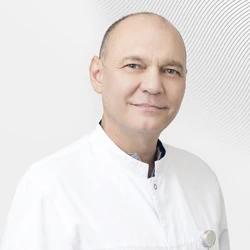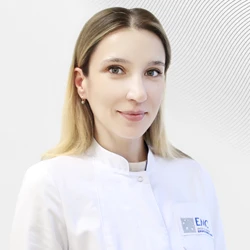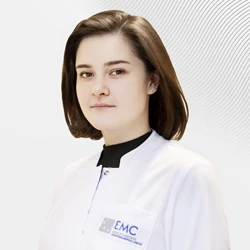Psoriasis treatment: modern techniques
Psoriasis is a chronic inflammatory skin disease with a hereditary predisposition characterized by complex changes in the upper layers of the skin, primarily increased skin cell division, which leads to the formation of psoriatic rashes. Psoriasis has numerous biochemical and immunological changes.
Psoriasis is registered everywhere. Psoriasis is most common in European countries (up to 2.9% of the population), with the lowest rates recorded in Asia and West Africa (0.4%). The share of psoriasis among the total number of skin diseases reaches 15%. On average, 4% of the general population has psoriasis. Recently, there has been an increase in severe forms of the disease that are resistant to treatment, and the percentage of patients with concomitant pathologies is also growing. Some patients with psoriasis develop progressive joint changes called psoriatic arthritis, which can lead to disability.
The presence of psoriasis is in itself a stressful factor for the patient, which significantly reduces the quality of life. In addition, the mechanism of development of psoriasis is in many ways similar to the mechanism of development of certain diseases of internal organs, primarily type 2 diabetes mellitus, obesity, hypertension and elevated blood cholesterol levels, which lead to the formation of atherosclerotic vascular plaques. Such changes, in turn, contribute to an increased risk of cardiovascular disease, stroke, and other complications. Therefore, psoriasis is not only a skin disease: it can indirectly have a negative impact on other organs and systems of the human body.
The etiology of psoriasis has not been fully studied, but there is a definite link between the occurrence of psoriasis and the presence of stress, foci of chronic infection, climatic changes, eating disorders, smoking, alcohol consumption, and a proven genetic predisposition to psoriasis.
There are several forms of psoriasis
- Vulgar.Areas of rashes in the form of nodules or plaques of red color, covered with silvery-white scales, are characterized by slightly raised above the surface of healthy skin. Rashes are localized most often on the extensor surfaces of the extremities, on the elbows, on the knees, on the scalp, in the lumbosacral region, on the buttocks, and may also be on the genitals.
- Teardrop-shaped.It is characterized by the presence of a large number of small dry red or purple, drop-like elements of the psoriatic lesion. The rashes are localized mainly on the skin of the trunk, less pronounced on the skin of the arms and legs. Very often, the first manifestation of teardrop-shaped psoriasis is preceded by an outbreak of streptococcal infection of the nasopharynx.
- Erythroderma. Psoriatic rashes spread to the entire surface of the body, including the face, hands, feet, and scalp.
- Pustular psoriasis. This is a rare form of psoriasis, when small superficial pustules appear on the surface of psoriatic plaques. These pustules are germ-free. Pustular psoriasis can affect only the palms and soles, or it can manifest itself on the entire surface of the body.
Vulgar
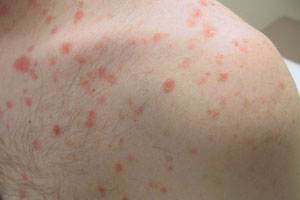
Teardrop-shaped
Erythroderma
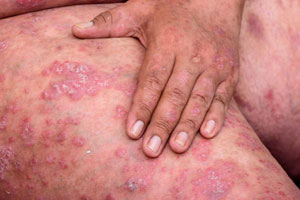
Pustular psoriasis
Often, rashes with psoriasis can be localized on the scalp and not affect other areas of the skin. In this case, patients are concerned about dry scalp, itching, a feeling of tightness and abundant fine-grained peeling, sometimes hair loss.
Psoriasis treatment
Treatment of psoriasis includes systemic therapy, topical (local) therapy and physiotherapy methods. At the moment, all modern knowledge, technologies and drugs for the treatment of psoriasis are collected in the EMC.
EMC Psoriasis treatment includes:
Systemic therapy, topical (local) therapy, and physiotherapy methods. At the moment, the EMC has the opportunity to treat psoriasis with modern methods. Dermatologists of our clinic use only those methods in the treatment of psoriasis that have proven their effectiveness all over the world.
The treatment of psoriasis in EMC includes:
-
A special diet that restricts the consumption of salty and fatty foods and easily digestible carbohydrates.
-
General and local drug therapy, which is prescribed depending on the stage of the disease, the prevalence of the skin process, and the clinical form of the disease. General therapy may include a vitamin A derivative (Acitretin), possibly prescribing drugs such as Methotrexate, Cyclosporine. Topical therapy includes products containing tar, corticosteroid ointments, creams and lotions, ointments with vitamin D, zinc pyrithione.
-
Biological therapy (the most modern treatment method). These are drugs based on monoclonal antibodies that block certain parts of the immune system that are involved in the development of psoriasis (for example, Enbrel, Stelara, Efleira, Cosentix, Skyrizi, etc.).
-
Physiotherapy treatment. PUVA therapy, narrow-wave phototherapy.
At the European Medical Center (Moscow), dermatologists individually approach each clinical case and choose the most optimal complex therapy for treatment. Psoriasis treatment at the Clinic of Dermatovenerology and Allergology-Immunology is carried out as part of a multidisciplinary team, when the decision on patient management tactics is made jointly by doctors of various related specialties. This approach allows you to achieve maximum therapeutic effect.
Why the EMC
The first and only clinic in Russia, created in the image of the world's leading clinics
EMC is a multidisciplinary center offering patients a high level of medical services and a personalized approach
Worldwide recognition and awards
 Learn more
Learn more
Worldwide recognition and awards
 Certificates and licenses
Certificates and licenses
Make an appointment for a consultation
Specify your contacts and we will contact you to clarify the details
Reviews
and new products of the EMC
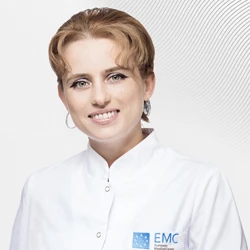
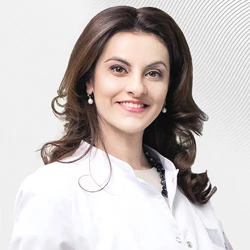
.webp)
.webp)
.webp)
